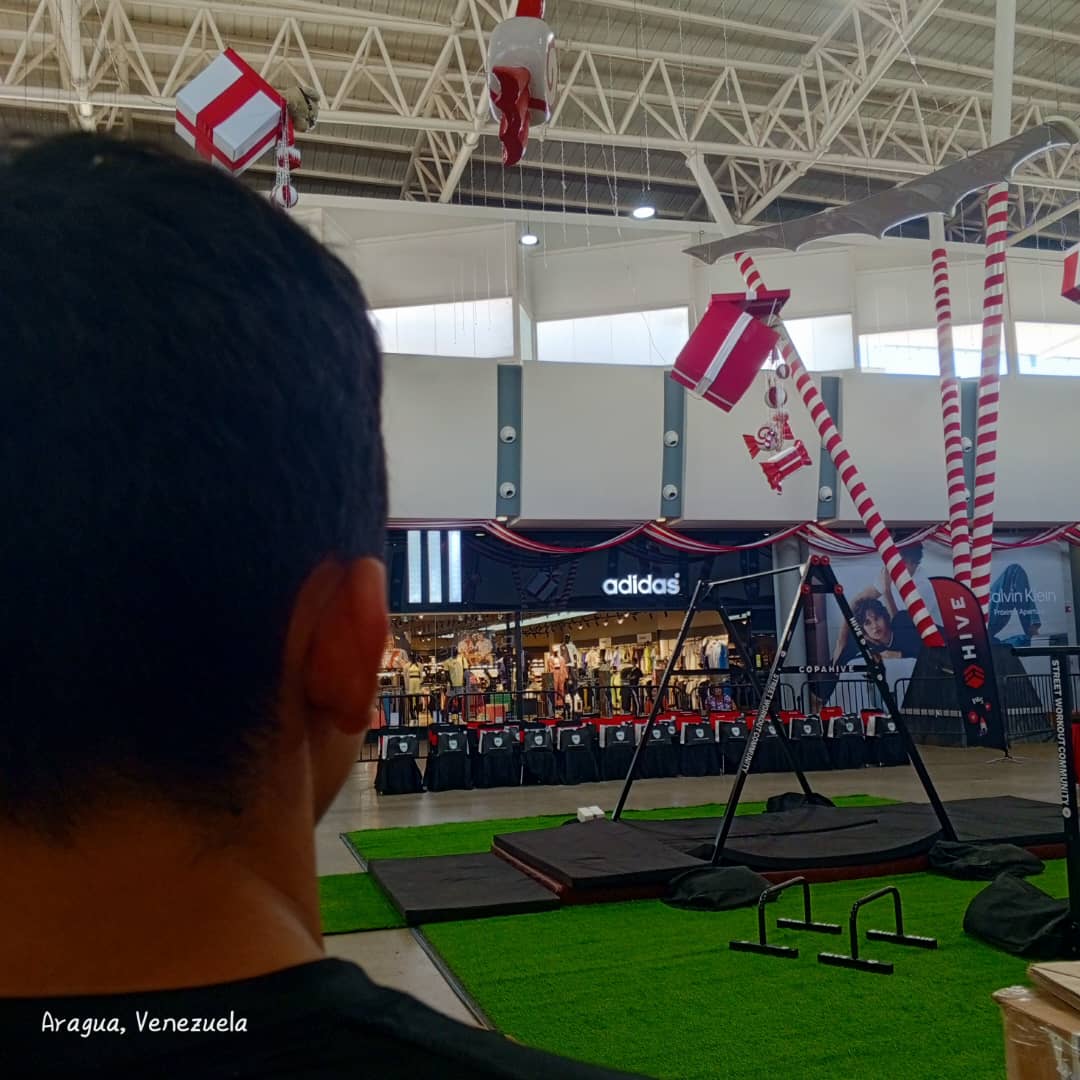
English
The base of the front does matter
Greetings to all, hivers, I hope you're doing great. The first thing I realized, or rather, the first thing I learned the hard way when I started training for the front lever, was that you can't progress without a firm foundation. At first glance, it's a dazzling and elegant movement; however, behind that image lies a great deal of effort, technique, and patience. In my experience, trying to force positions without being ready not only caused me frustration but also made me understand the importance of intelligent physical preparation.
The front lever is much more than pure strength. It requires total body control, a harmony between alignment, mastery, and power. From my perspective, I can assure you that building that foundation is a process as difficult as it is rewarding. Watching other athletes or training partners, I realize the same thing happens: those who respect the process progress, and those who rush it get injured or become ill. stagnate.
 |  |
|---|

Pulling strength was the first thing I worked on, especially the rear delts, traps, and lats. Without that strength, it's impossible to keep your body parallel to the floor. At first, my pull-ups were sparse and disorganized, but after persisting with them, alternating between Australian rows, explosive pull-ups, and weighted pull-ups, I began to notice a real change. Reaching my goal of 8 to 12 pull-ups with 30% of my additional body weight took months, but it represented a turning point in my progress.
The core is another area I underestimated at first. You think that defined abs are the key, but the front lever requires a completely different isometric strength. Exercises like the hollow body hold and dragon flag became essential in my workouts. I learned to engage not only my abs, but also my lower back and glutes, all at the same time. That muscle communication allowed me to start holding positions without my hips dropping or wobbling.
 |  |
|---|

One of the most technical things (and less obvious to the untrained) is scapular control. Being able to retract and depress my scapulae without bending my elbows took me longer than I expected. Scapular pull-ups, as simple as they are, helped me feel like my arms were truly "connected" to my back. This control kept me aligned and saved me from shoulder and lower back pain.
If I learned anything, it's that the front lever isn't achieved overnight. You have to take it in stages; each one teaches you something different. I started with the front lever tuck, which seemed easy until I tried holding it for more than five seconds. Then I moved on to the advanced tuck, one leg, and straddle. In each phase, I varied between isometric and dynamic: static holds and controlled negatives. And so I got stronger little by little.
 |  |
|---|

Today I appreciate not only the last step, but everything that led me to it. The front lever was a metaphor for my own process: slow, full of adjustments, frustrating, but always with a direction. The structure I built wasn't just physical, it was mental. It taught me discipline, patience, and, above all, respect for my body. I'm omarzv-sw, and this was my post. See you later!
Spanish
La base de el front si importa
Un saludo a todos, hivers, espero estén de maravilla. Lo primero que comprendí o, mejor dicho, lo primero que aprendí de manera dura cuando empecé a entrenar para conseguir el front lever fue que no se puede avanzar sin una base firme. A simple vista, es un movimiento deslumbrante y elegante; sin embargo, detrás de esa imagen existe una gran cantidad de esfuerzo, técnica y paciencia. En mi experiencia, el intentar forzar posiciones sin estar listo no solo me causó frustración, sino que además me hizo entender la importancia de una preparación física inteligente.
El front lever es mucho más que pura fuerza. Necesita un control total del cuerpo, una armonía entre la alineación, el dominio y la potencia. Desde mi perspectiva, puedo asegurar que la construcción de esa base es un proceso tan difícil como satisfactorio. Al ver a otros deportistas o compañeros de entrenamiento, me doy cuenta de que ocurre lo mismo: aquellos que respetan el proceso avanzan y los que lo apresuran se lesionan o se estancan.
 |  |
|---|

La fuerza de tracción fue lo primero en lo que trabajé, sobre todo en los deltoides posteriores, trapecios y dorsales. Sin esa fuerza, no es posible mantener el cuerpo en paralelo con el suelo. Al principio, mis dominadas eran escasas y desorganizadas, pero tras persistir con ellas alternando entre remos australianos, dominadas explosivas y dominadas con lastre empecé a percibir un cambio verdadero. Alcanzar la meta de 8 a 12 dominadas con un 30% de mi peso corporal adicional fue algo que me llevó meses, pero representó un punto de inflexión en mi avance.
El core es otra de las partes que infravaloré al principio. Uno cree que con los abdominales marcados ya está todo hecho, pero el front lever requiere una fuerza isométrica totalmente diferente. Ejercicios como el hollow body hold y el dragon flag se volvieron imprescindibles en mis entrenamientos. Aprendí a encender no solo el abdomen, sino también la espalda baja y los glúteos, todo al mismo tiempo. Esa comunicación entre músculos me permitió comenzar a sostener posiciones sin que se me cayera la cadera ni me tambaleara.
 |  |
|---|

Una de las cosas más técnicas (y menos evidentes para los no entrenados) es el control escapular. Poder retraer y deprimir las escápulas sin flexionar los codos me llevó más tiempo de lo que esperaba. Las dominadas escapulares, por sencillas que sean, me ayudaron a sentir que mis brazos estaban de verdad "conectados" a la espalda. Este control me mantuvo alineado y me salvó de dolores de hombros y espalda baja.
Si algo aprendí, es que el front lever no se logra de la noche a la mañana. Hay que ir por etapas, cada una enseña algo diferente. Comencé con el tuck front lever, que parecía fácil hasta que intenté mantenerlo más de 5 segundos. Luego pasé al advanced tuck, one leg y straddle. En cada fase variaba entre isométrico y dinámico: mantenimientos estáticos y negativas controladas. Y así fui fortaleciendo poco a poco.
 |  |
|---|

Hoy no aprecio solo el último paso, sino todo lo que me trajo hasta él. El front lever fue una metáfora de mi propio proceso: lento, lleno de ajustes, frustrante, pero siempre con una dirección. La estructura que erigí no fue solo física, fue mental. Me enseñó disciplina, paciencia y, sobre todo, respeto por mi cuerpo. Soy omarzv-sw y esta fue mi publicación. ¡Hasta luego!

| Thank you for viewing my post we will see you soon💪🏻. | Gracias por ver mi publicacion nos veremos pronto💪🏻. |
|---|
| Credits | Créditos |
|---|---|
| Images and separators | Imágenes y separadores |
| @omarzv-sw | @omarzv-sw |
| date | fecha |
| 21/08/2025 | 08/21/2025 |
| Device | Dispositivo |
| TECNO SPARK 10 Pro | TECNO SPARK 10 Pro |
| Cover created with: | Portada creada con: |
| Canva | Canva |
| Translator: | Traductor: |
| Translate Google | Translate Google |
✨The only way to do great work is to love what you do.✨
✨El único modo de hacer un gran trabajo es amar lo que haces.✨
.jpeg) |
|---|
| If you liked my content you can visit my social networks | Si te gusto mi contenido puedes visitar mis redes sociales |
|---|

Posted Using INLEO